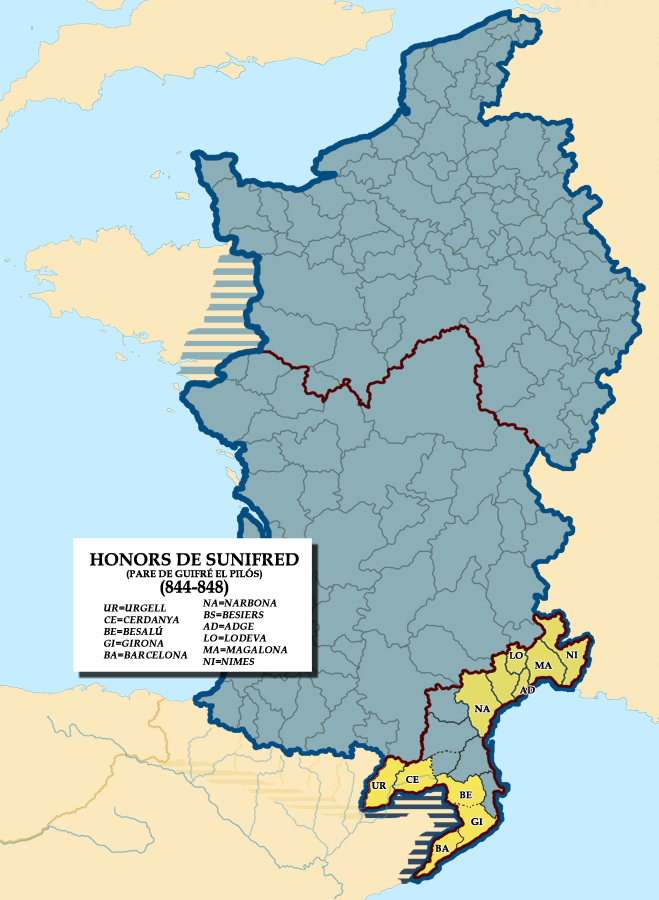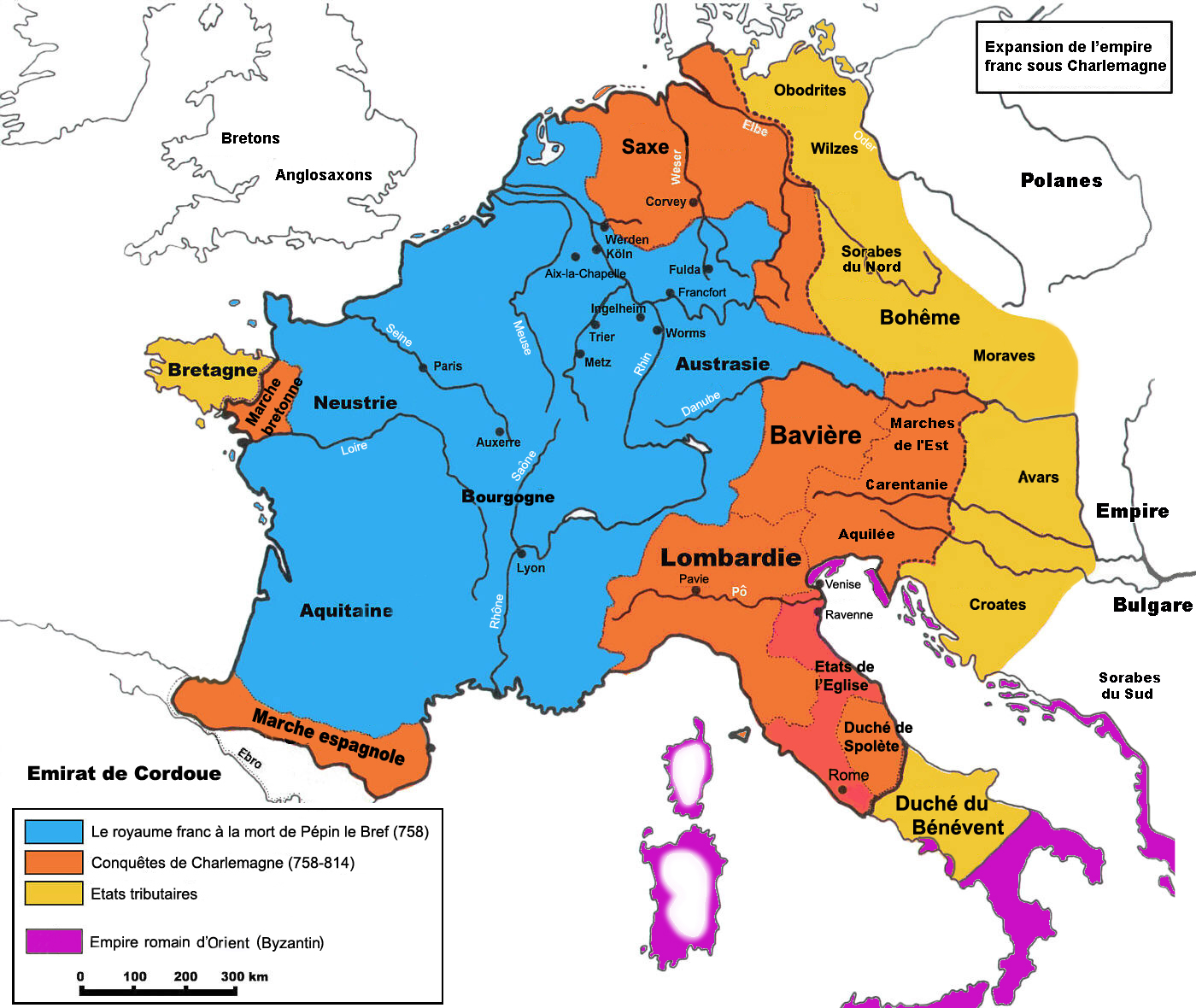|
Guiscafred
Guisclafred (died circa 821) was the Count of Carcassonne from 810. He was the eldest son and successor of Bello of Carcassonne. His brothers were Sunyer I of Ampurias, Sunifred I of Barcelona, and Oliba I of Carcassonne. When Bello died, his sons partitioned his domains between them, according to the eldest the chief city of Carcassonne Carcassonne is a French defensive wall, fortified city in the Departments of France, department of Aude, Regions of France, region of Occitania (administrative region), Occitania. It is the prefectures in France, prefecture of the department. .... He was succeeded after a short reign by his brother Oliba. 820s deaths Counts of Carcassonne Year of birth unknown Nobility of the Carolingian Empire {{s-end ... [...More Info...] [...Related Items...] OR: [Wikipedia] [Google] [Baidu] |
Count Of Carcassonne
The County of Carcassonne (Occitan: ''Comtat de Carcassona'') was a medieval fiefdom controlling the city of Carcassonne, France, and its environs. It was often united with the County of Razès. The origins of Carcassonne as a county probably go back to the Visigothic period in Septimania, but the first count known by name is Bello of the time of Charlemagne. Bello founded a dynasty, the Bellonids, which would rule many ''honores'' in Septimania and Catalonia for the centuries. Bello was a loyal Carolingian follower and his successor in the county were Carolingian appointees down to about the time of Oliba II, at which point the counties in the outlying regions were beginning to become hereditary possessions in the hands of locally well-endowed families. After Oliba, who ruled both Carcassonne and Razès, his patrimony was ruled jointly by his sons and grandsons. On the death of Acfred II in 933, Carcassonne passed to a woman and, by marriage, to the counts of Comminges. The ... [...More Info...] [...Related Items...] OR: [Wikipedia] [Google] [Baidu] |
Bello Of Carcassonne
Bello (c. 755 – 810) was Count of Carcassonne from 790 until his death. He was the founder of the Bellonid Dynasty of Carcassonne and Razès which reached its apex in Wilfred the Hairy, progenitor of the House of Barcelona. Bello married Ermentrude de Ampurias, several children have been suggested for him: * Guisclafred, his successor in Carcassonne * Oliba I, Count of Carcassonne and Razès * Sunyer I, Count of Empúries * Sunifred I, Count of Barcelona - may have been his son or possibly son-in-law. He is mentioned to be the brother of Sunyer I; might have been his brother-in-law. * Argila of Razès, Count of Carcassonne and Razès * Bera of Barcelona, Count of Carcassonne and Razès, Count of Barcelona, Girona, Ausona, Empúries Argila and Bera are less likely to have been sons of Bello. Bera is also noted to be the son of William of Gellone William of Gellone ( 755 – 28 May 812 or 814), the medieval William of Orange, was the second Duke of Toulouse from 790 until ... [...More Info...] [...Related Items...] OR: [Wikipedia] [Google] [Baidu] |
Sunyer I Of Ampurias
Sunyer ( Catalan) or Suñer/Suniario (Spanish), from Latin ''Suniarius'', possibly from Proto-Germanic *sunjō ("truth, protest"), may refer to: *Sunyer, Count of Barcelona (870–950) *Sunyer I of Empúries (834–848) *Sunyer II of Empúries (862–915) *Sunyer I of Pallars (948–1010) *Joaquim Sunyer Joaquim Sunyer (; 1874 in Sitges – 1956) was a Catalonia, Catalan painter often linked to the Noucentisme movement. He began his artistic education with his uncle, Joaquim Mir, later moving to Barcelona where his fellow students included Joaqu ... (1874–1956), Catalan artist See also * Sunyer, Lleida, a municipality in the ''comarca'' of Segrià, Catalonia {{disambig, Surname Catalan-language surnames ... [...More Info...] [...Related Items...] OR: [Wikipedia] [Google] [Baidu] |
Sunifred I, Count Of Barcelona
Sunifred (died 848) was the Count of Urgell and Cerdanya from 834 to 848, and the Count of Barcelona as well as many other Catalan and Septimanian counties, including Ausona, Besalú, Girona, Narbonne, Agde, Béziers, Lodève, County of Melgueil, Melgueil, Conflent and Nîmes, from 844 to 848. He may have been the son of Bello of Carcassonne, Belló, Count of Carcassonne, or, more probably, his son-in-law. In 834, he was named Count of Urgell and Cerdanya by Louis the Pious, Holy Roman Emperor; at the time these counties were under the control of Aznar Galíndez I, an ally of the Banu Qasi. Sunifred conquered Cerdanya in 835 and Urgell three years later (838). In the dynastic struggles that accompanied the three years between Louis the Pious' death (840) and the Treaty of Verdun (843), Bernard of Septimania, Count of Barcelona (and many other marches and counties, including Septimania, Girona, Narbonne, Béziers, Agde Agde (; ) is a commune in the southern French depart ... [...More Info...] [...Related Items...] OR: [Wikipedia] [Google] [Baidu] |
Oliba I Of Carcassonne
Oliba I of Carcassonne (died 837) was a count of Carcassonne in the 9th century. He was the son of Bello of Carcassonne, and brother (or cousin) of Sunifred I of Barcelona. He succeeded to the county of Carcassonne (as well as to the county of Razès) after his brother Guisclafred had died without heirs. Oliba married to Elmetruda and Richelda, with whom he had three sons: Oliba II, Sunifred (who was abbot of Lagrasse) and Acfred. After his death the county of Carcassonne was ruled by Bernard of Septimania Bernard (or Bernat) of Septimania (795–844), son of William of Gellone and cousin of Charlemagne, was the Duke of Septimania and Count of Barcelona from 826 to 832 and again from 835 until his execution, and also Count of Carcassonne from 837. H .... {{DEFAULTSORT:Oliba 01 Of Carcassonne 9th-century births 9th-century deaths Counts of Carcassonne Nobility of the Carolingian Empire ... [...More Info...] [...Related Items...] OR: [Wikipedia] [Google] [Baidu] |
Carcassonne
Carcassonne is a French defensive wall, fortified city in the Departments of France, department of Aude, Regions of France, region of Occitania (administrative region), Occitania. It is the prefectures in France, prefecture of the department. Inhabited since the Neolithic Period, Carcassonne is located in the plain of the Aude (river), Aude between historic trade routes, linking the Atlantic to the Mediterranean Sea and the Massif Central to the Pyrénées. Its strategic importance was quickly recognised by the Ancient Rome, Romans, who occupied its hilltop until the demise of the Western Roman Empire. In the fifth century, the region of Septimania was taken over by the Visigoths, who founded the city of Carcassonne in the newly established Visigothic Kingdom. Its citadel, known as the Cité de Carcassonne, is a medieval fortress dating back to the Roman Gaul, Gallo-Roman period and restored by the theorist and architect Eugène Viollet-le-Duc between 1853 and 1879. It was adde ... [...More Info...] [...Related Items...] OR: [Wikipedia] [Google] [Baidu] |
820s Deaths
8 (eight) is the natural number following 7 and preceding 9. Etymology English ''eight'', from Old English '', æhta'', Proto-Germanic ''*ahto'' is a direct continuation of Proto-Indo-European '' *oḱtṓ(w)-'', and as such cognate with Greek and Latin , both of which stems are reflected by the English prefix oct(o)-, as in the ordinal adjective ''octaval'' or ''octavary'', the distributive adjective is ''octonary''. The adjective ''octuple'' (Latin ) may also be used as a noun, meaning "a set of eight items"; the diminutive ''octuplet'' is mostly used to refer to eight siblings delivered in one birth. The Semitic numeral is based on a root ''*θmn-'', whence Akkadian ''smn-'', Arabic ''ṯmn-'', Hebrew ''šmn-'' etc. The Chinese numeral, written (Mandarin: ''bā''; Cantonese: ''baat''), is from Old Chinese ''*priāt-'', ultimately from Sino-Tibetan ''b-r-gyat'' or ''b-g-ryat'' which also yielded Tibetan '' brgyat''. It has been argued that, as the cardinal num ... [...More Info...] [...Related Items...] OR: [Wikipedia] [Google] [Baidu] |
Counts Of Carcassonne
The County of Carcassonne (Occitan: ''Comtat de Carcassona'') was a medieval fiefdom controlling the city of Carcassonne, France, and its environs. It was often united with the County of Razès. The origins of Carcassonne as a county probably go back to the Visigothic period in Septimania, but the first count known by name is Bello of the time of Charlemagne. Bello founded a dynasty, the Bellonids, which would rule many ''honores'' in Septimania and Catalonia for the centuries. Bello was a loyal Carolingian follower and his successor in the county were Carolingian appointees down to about the time of Oliba II, at which point the counties in the outlying regions were beginning to become hereditary possessions in the hands of locally well-endowed families. After Oliba, who ruled both Carcassonne and Razès, his patrimony was ruled jointly by his sons and grandsons. On the death of Acfred II in 933, Carcassonne passed to a woman and, by marriage, to the counts of Comminges. The ... [...More Info...] [...Related Items...] OR: [Wikipedia] [Google] [Baidu] |
Year Of Birth Unknown
A year is a unit of time based on how long it takes the Earth to orbit the Sun. In scientific use, the tropical year (approximately 365 solar days, 5 hours, 48 minutes, 45 seconds) and the sidereal year (about 20 minutes longer) are more exact. The modern calendar year, as reckoned according to the Gregorian calendar, approximates the tropical year by using a system of leap years. The term 'year' is also used to indicate other periods of roughly similar duration, such as the lunar year (a roughly 354-day cycle of twelve of the Moon's phasessee lunar calendar), as well as periods loosely associated with the calendar or astronomical year, such as the seasonal year, the fiscal year, the academic year, etc. Due to the Earth's axial tilt, the course of a year sees the passing of the seasons, marked by changes in weather, the hours of daylight, and, consequently, vegetation and soil fertility. In temperate and subpolar regions around the planet, four seasons ar ... [...More Info...] [...Related Items...] OR: [Wikipedia] [Google] [Baidu] |
Nobility Of The Carolingian Empire
Nobility is a social class found in many societies that have an aristocracy. It is normally appointed by and ranked immediately below royalty Royalty may refer to: * the mystique/prestige bestowed upon monarchs ** one or more monarchs, such as kings, queens, emperors, empresses, princes, princesses, etc. *** royal family, the immediate family of a king or queen-regnant, and sometimes h .... Nobility has often been an estate of the realm with many exclusive functions and characteristics. The characteristics associated with nobility may constitute substantial advantages over or relative to non-nobles or simply formal functions (e.g., Order of precedence, precedence), and vary by country and by era. Membership in the nobility, including rights and responsibilities, is typically Hereditary title, hereditary and Patrilinearity, patrilineal. Membership in the nobility has historically been granted by a monarch or government, and acquisition of sufficient power, wealth, ownerships, ... [...More Info...] [...Related Items...] OR: [Wikipedia] [Google] [Baidu] |



